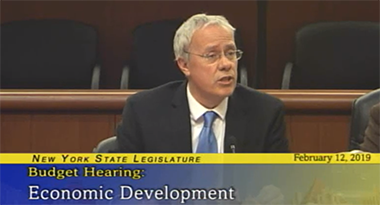State Officials Turn to UAlbany’s Weather Enterprise For Insight on Climate Change, Economic Development
.jpg) |
|
DAES professor Mathias Vuille testified at the Senate Standing Committee on Environment Conservation’s public hearing on Tuesday. |
ALBANY, N.Y. (Feb. 14, 2019) – Mathias Vuille has spent 30 years observing the impacts of climate change on our environment, which he described to state lawmakers during the New York Senate’s first of three hearings on climate change legislation.
Connecting Science and Policy
Vuille, a professor in the Department of Atmospheric and Environmental Sciences, was invited to the State Capitol Building in Albany on Tuesday to testify at the Senate Standing Committee on Environment Conservation’s public hearing on the proposed Climate and Community Protection Act.
The bill would establish a New York State Climate Action Council, direct the state to establish greenhouse gas emissions limits and set benchmarks for moving New York’s electric supply toward greater reliance on renewable energy systems.
Speaking strictly as a climate scientist, Vuille discussed the global need for climate adaptation and mitigation.
“Our global climate is changing, and this change is driven by increased concentrations of greenhouse gases in our atmosphere – gases that are emitted, first and foremost, through burning of fossil fuels, Vuille said. “The evidence for this is unequivocal, as stated by all major scientific bodies.”
Vuille grew up in Switzerland, a country that is projected to lose 95 percent of its glaciers by the end of this century. He has dedicated his research career – which spans three decades – to studying the climate change impacts in tropical mountain environments, such as the Andes, that depend on glacial melting as a water resource.
Though New York has no glaciers, Vuille explained on Tuesday that climate change is still impacting the state, “just in different ways.” He cited examples such as increases in intense storms, earlier flowering and greening of plants, more cases of Lyme disease and a decrease in spring snow cover, which, together with warmer nighttime temperatures, may threaten the state’s ski resorts.
He concluded by stating: “We have started an experiment with our planet, without considering what the impacts will be... Whether we like it or not, we now have little choice but to try to mitigate climate change and, at the same time, adapt to its impacts.”
Watch Vuille’s testimony starting at 2:29:00.
 |
|
Chris Thorncroft, ASRC interim director, touted the Center of Excellence in Atmospheric and Environmental Prediction and Innovation during Tuesday's joint legislative hearing. |
Economic Driver
Chris Thorncroft, interim director of the Atmospheric Sciences Research Center, and Jan Woodcock, the University’s executive director of weather innovation, also spoke with state government officials on Tuesday during the final joint legislative hearing on the 2019-2020 executive budget proposal. The hearing focused on economic development.
Thorncroft and Woodcock shared the successes of UAlbany’s Center of Excellence in Atmospheric and Environmental Prediction and Innovation, which taps into the University’s 120-plus atmospheric, climate and environmental researchers on campus - the largest concentration in the state – to develop smart weather-based solutions for business partners across many different industries.
The Center has generated $3.31 million in direct financial impact over the last three years and aspires to be fully-funded at the $1 million level in the near future, thanks in part to $250,000 in seed funding secured by Assemblywoman Patricia Fahy four years ago and each year since.
“Through the [Center of Excellence in Atmospheric and Environmental Prediction and Innovation], businesses have direct access to arguably the most advanced weather and climate industry-focused ecosystem in the nation,” said Thorncroft, who is also the Center’s director.
“In New York State alone, $142 billion in economic activity is affected by variations in weather. Businesses that harness the power of better weather and climate information can increase profits resulting in positive state economic impacts," he added.
“This Center puts weather solutions in the hands of industry partners across the state to empower them to make smarter weather risk management decisions,” said Woodcock. “We are laying the foundation to transform weather into one of New York’s most dynamic, high-impact and job creating economies.”
Watch both of their testimonies starting at 3:27:00.
![]() For more news, subscribe to UAlbany's RSS headline feeds
For more news, subscribe to UAlbany's RSS headline feeds
A comprehensive public research university, the University at Albany-SUNY offers more than 120 undergraduate majors and minors and 125 master's, doctoral and graduate certificate programs. UAlbany is a leader among all New York State colleges and universities in such diverse fields as atmospheric and environmental sciences, business, education, public health,health sciences, criminal justice, emergency preparedness, engineering and applied sciences, informatics, public administration, social welfare and sociology, taught by an extensive roster of faculty experts. It also offers expanded academic and research opportunities for students through an affiliation with Albany Law School. With a curriculum enhanced by 600 study-abroad opportunities, UAlbany launches great careers.


